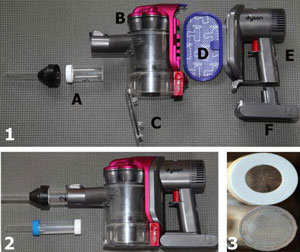
The modified Dyson DC34 vacuum cleaner for bed bug collection: (1) A detailed view of the parts; (A) BioQuip sampling vial; (B) plastic jar; (C) trapdoor; (D) filter; (E) digital motor; (F) battery; (2) A view of the vacuum ready to be used for bed bug collection. A BioQuip sampling vial is set, and a homemade plastic vial is presented below. (3) A detailed view of the BioQuip sampling vial apertures with front and back views. PHOTO: Entomological Society of America
As the industry brings National Bed Bug Awareness Week to a close this weekend, we came across this headline: “French researchers develop new device to collect bed bugs.”
Upon closer inspection, we learned that the research was originally published in the Entomological Society of America’s (ESA’s) Journal of Medical Entomology. A link to the original article is here.
The tool the research team created — from a modified Dyson DC34 vacuum cleaner, no less — is not meant for control, but rather for the field collection of intact samples for laboratory testing.
As the literature and resulting press release explain, in the past researchers have collected bed bugs with a mouth aspirator, nicknamed “pooter,” which they compare to a “mouth-powered vacuum” that isn’t powerful enough to collect bugs or eggs hidden in crevices or attached to mattresses (not to mention the public health risk of using one’s mouth to collect the stuff). Alternatively, when they use more traditional vacuum cleaners, the bugs can be damaged and more difficult to study.
In a bed bug-infested apartment where the device was tested, the modified Dyson collected more than 700 (undamaged) bed bugs in under 15 minutes, including adults, larvae and eggs. Bonus: It’s lightweight and easy to clean.
In light of this initial success, the sky’s the limit on what the modified vacuum can mean long-term for entomologists.
“The modified vacuum has other uses besides collecting bed bugs,” says co-author Dr. Jean-Michel Bérenger. “We have already tested it on lice, and we will also test it for fleas. It’s not adapted for fragile insects such as mosquitoes, as it’s too powerful, but I think it will be used for crop pest collecting or by entomologists using mouth aspirators in the field, like coleopterists collecting under loose bark or in caves where there is often a risk of contamination, with histoplasmosis for example.”
So, now it’s your turn: Do you collect bed bug samples at accounts, or just vacuum them as much as possible, intactness not a concern? If you do, what do you use to collect them? Sound off in the comments below!
How much does this unit cost with all componets?
Thanks for inquiring, Scott, but to our knowledge this is still at the prototype stage and not available for sale. — The Eds.